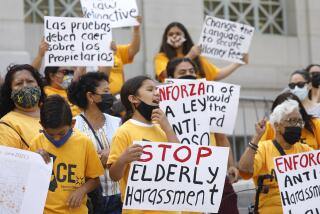Tackling a Very Tough Problem : Workplace: Progressive employers are increasingly adopting policies to prevent offensive behavior.
There was a “girlie” calendar hanging in a factory supervisor’s office when Sinclair E. Hugh came to call. At another small business, he overheard a woman telling a male co-worker to “quit hitting me on the butt.”
Hugh, an Irvine-based management consultant, dealt with both situations quickly. The calendar came down. The co-worker was advised against repeating such offensive behavior.
Most instances of potential sexual harassment in the workplace are not so easy to spot--or root out.
But consultants, personnel directors and--especially--lawyers say companies today have no choice but to confront the complex issues of sexual harassment now pushed so forcefully onto the public agenda by the imbroglio over Supreme Court nominee Clarence Thomas.
Smaller and middle-size companies, with more limited resources, have been slower to act. But larger employers “face this issue more and more--(and) they’ve decided they better put out the fires and stop it from happening,” said Judith E. Kurtz, managing attorney of Equal Rights Advocates, a public-interest law firm in San Francisco.
Attorney Joseph E. Wiley, whose Emeryville, Calif., law firm represents companies in labor and employment disputes, said he worries about the growing number of cases alleging sexual harassment.
“A lot of cases we settle, because there are real problems” with the behavior of the company or its managers, Wiley said. Indeed, in courtrooms across the country, jury awards to victims of sexual harassment have been climbing past the $1-million mark.
Wiley advises his clients to implement anti-sexual harassment policies and programs and to enforce them diligently.
Progressive employers are following such advice. The California Air Resources Board’s policy, for example, warns that “leering,” “looking someone up and down” or even impeding someone’s movement can be regarded as sexual harassment.
An estimated 85% to 90% of the agency’s 900 employees have gone through special sensitivity training programs; investigation of complaints begins within 24 hours.
“People know that we’re serious about these issues,” said Gayle Yost, who heads the agency’s equal employment opportunity office. As a result, she said, the offensive practice is halted almost immediately in nearly all of the dozen or so cases her office receives each year.
But the most important component of any anti-harassment policy, say attorneys and consultants, has to be a commitment that begins at the very top of the company.
“A chief executive officer (cannot do) what the Senate Judiciary Committee did--brush allegations under the rug,” said Freada Klein, a Cambridge, Mass., consultant who has been dealing with the problems of sexual harassment in the workplace for 15 years.
Unions claim to have been among the leaders in fighting sexual harassment on the job.
In 1979, the United Auto Workers broke new ground by negotiating a contract with Boston University that required the school to adopt a policy barring sexual harassment.
Among other things, the contract guaranteed a transfer to any employee who filed a sexual harassment complaint and wanted to move to another department. That provision was included to protect employees who lose their grievances from being in the awkward position of working for a boss whom they accused of sexual harassment.
The UAW has also tried to educate its officials and members about sexual harassment by showing a 32-minute video titled “Would You Let Someone Do This to Your Sister?”
Dottie Jones, assistant director of the UAW’s Women’s Department in Detroit, said sexual harassment is prevalent in blue-collar workplaces where newly hired women are given job training by men.
Jones said these women often put up with offensive comments rather than complain because they fear that their male trainers will “withhold vital information that will mean they can’t fulfill their dream of becoming electricians, pipe fitters, whatever.”
The situation is similar, Jones said, among women graduate students whose careers hinge on the recommendations of their mentors.
“Any woman who is entering the workplace today has a good chance of experiencing unwanted sexual attention--any woman, from waitresses up to doctors,” Jones said.
Added Abby Leibman, a managing director of the California Women’s Law Center in Santa Monica: “Essentially, with sexual harassment it’s a power issue. It is not about mutual attraction and it’s not about sex. It’s about somebody abusing his or her power in the workplace.”
The Newport Beach law firm of Pettis, Tester, Kruse & Krinsky says it practices what it preaches to clients: You have to take complaints of harassment seriously, and you should have a formal program to deal with them.
At the mid-size firm of about 50 lawyers, complaints get an informal hearing from one of the firm’s top executives. If the complaint is found to have merit, it could draw anything from mandatory counseling to a reprimand to termination, depending on the seriousness of the offense.
Essential to curbing sexual harassment in the workplace, experts say, are training programs that clarify what kinds of remarks and gestures can be regarded as sexually offensive. One key problem is that men and women often have dramatically different views of what constitutes sexual harassment.
The UAW’s Jones said that in her training programs she emphasizes the distinction between friendly banter and offensive language. “I don’t have a problem with someone saying, ‘Dottie, you look nice today.’ What I do have a problem with is someone saying, ‘I like the way those jeans are hugging your behind.’ Some men think that’s a compliment,” Jones said. “They just don’t get it.”
Times staff writers Michael Flagg in Orange County and Julie Tamaki in Los Angeles also contributed to this story.
More to Read
Inside the business of entertainment
The Wide Shot brings you news, analysis and insights on everything from streaming wars to production — and what it all means for the future.
You may occasionally receive promotional content from the Los Angeles Times.










